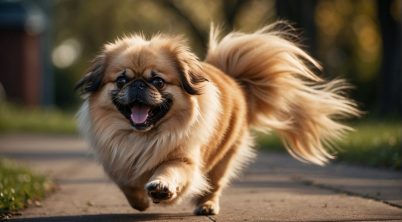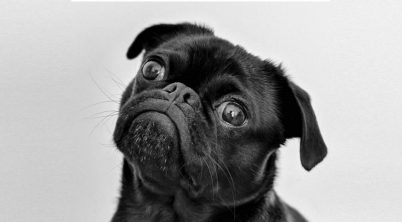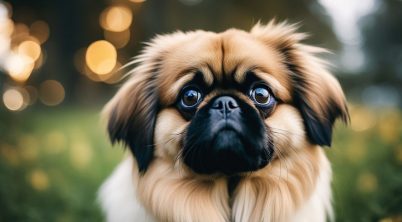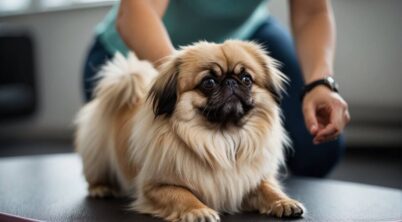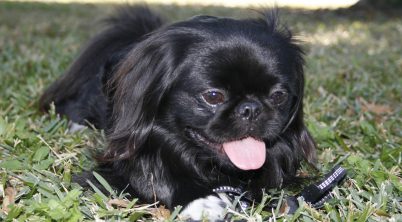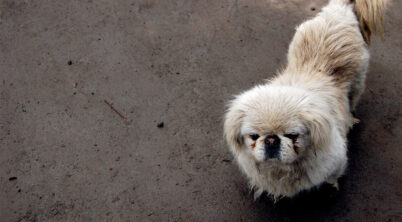The Pekingese, a toy dog breed hailing from ancient China, is characterized by its distinctive flat face and expressive demeanor. While not all Pekingese dogs drool excessively, some owners may find that their Pekingese exhibit this trait. Drooling in Pekingese can be due to a variety of reasons, ranging from natural physiological processes to health concerns. It’s important for Pekingese owners to understand when drooling may signal a need for veterinary attention and when it’s simply a part of their dog’s normal behavior.
Excessive drooling in Pekingese is not typically characteristic of the breed, but it can occur. Certain factors like the dog’s unique mouth structure, teething in puppies, or a response to stimuli such as food or stress may cause a Pekingese to drool more than usual. It’s essential to distinguish between normal drooling and instances where excessive saliva production might indicate underlying health issues, such as dental problems, heatstroke, or anxiety.
Responsible Pekingese ownership entails maintaining a clean and comfortable living environment for both the dog and its human companions. Managing and understanding a Pekingese’s drooling is part of ensuring the well-being of the dog and maintaining a dry, clean household. As such, knowing how to properly care for a Pekingese includes recognizing the causes and treatment options for excessive drooling.
Pekingese Dog Drool
Pekingese dogs, originating from China, are an ancient breed once owned by Chinese royalty. These small dogs were highly valued by emperors and nobles, and it was said that stealing one could result in the death penalty. Their history is entwined with British troops, who brought the dogs to Europe after the Second Opium War, with one even finding its way into the care of Queen Victoria.
When it comes to drooling, Pekingese dogs are not typically known for excessive salivation. However, like any dog breed, they may drool in response to specific stimuli or health issues. Occasional drooling may be the result of anticipation for food or excitement.
Common Causes of Drooling in Pekingese Dogs:
- Anticipation of food: Seeing or smelling their preferred meals can trigger a drooling response.
- Oral health issues: Problems with teeth or gums can sometimes lead to increased drooling.
- Heat and dehydration: Warm environments or lack of water can induce drooling, serving as a cooling mechanism.
To manage drooling in Pekingese dogs, maintaining regular dental check-ups is crucial. Ensuring they are well-hydrated, particularly on hot days, can prevent heat-induced drool. If a Pekingese dog is drooling excessively and without a clear cause, seeking veterinary advice is recommended as it may be indicative of underlying health issues.
Owners looking to minimize drool should maintain a clean, dry living area for their pet and provide appropriate care specific to the breed’s needs. This includes regular grooming, as Pekingese dogs have a thick double coat that requires attention to prevent matting and to keep them comfortable.
Breed Characteristics and Appearance
The Pekingese boasts a regal and distinctive appearance, marked by a compact body that exudes a stoic and composed demeanor. In terms of size, these small yet sturdy canines generally weigh between 7 to 14 pounds and stand 6 to 9 inches tall at the shoulder.
With a luxurious coat that comes in a variety of colors—red, white, sable, black and tan, and cream—the Pekingese carries itself with an air of aristocratic confidence. The breed’s coat requires consistent grooming to remain in top condition, highlighting the importance of regular maintenance.
Size and Build
- Height: 6 to 9 inches at the shoulder
- Weight: 7 to 14 pounds
- Body: Long, low, and compact with somewhat bowed limbs
Coat and Color
- Texture: Long and flowing
- Variety: Broad range, including red, white, sable, black and tan, and cream.
The temperament of the Pekingese is as noteworthy as its looks. While they are loving and become deeply attached to their families, they also have a self-important streak owing to their history as dogs of Chinese royalty. This breed’s nature is often described as poised and self-assured.
Despite their small stature, Pekingese dogs do not typically drool extensively. Their well-defined facial structure includes a short snout which does not lend itself to excessive drooling, unlike some other breeds. However, it’s important to monitor for any changes that could indicate a health issue.
Ultimately, the appearance of the Pekingese reflects its noble lineage, and these dogs carry themselves with a demeanor that commands admiration. They are happiest in the company of their human companions, proving that their loyalty is as steadfast as their notable presence.
Health and Wellness
In Pekingese dogs, health and wellness concerns such as dental health directly impact instances of drooling. Due to their brachycephalic nature, these dogs face unique health challenges that require attentive care.
Dental Health and Drooling
Pekingese dogs are prone to dental problems which can lead to excessive drooling. Their flattened face, or flat face, characteristic of brachycephalic breeds, contributes to dental crowding, increasing the risk of periodontal disease. A regular dental care routine is crucial, including teeth cleaning and veterinary check-ups, to prevent the buildup of plaque and tartar which can exacerbate drooling.
Drooling in Pekingese may also signal underlying health issues unrelated to dental health, like brachycephalic syndrome, which can affect breathing and lead to overheating. As these dogs cannot regulate their temperature effectively, they may drool more to attempt to cool down.
Owners should be mindful of their Pekingese’s behavior, as excessive drooling can also be a symptom of anxiety or stress. Implementing a calm and stable environment reduces anxiety-induced drooling.
Additionally, conditions such as intervertebral disc disease may manifest through drooling if the dog is in pain or discomfort. Veterinary consultation is crucial whenever a Pekingese exhibits abnormal or excessive saliva production, to ensure proper diagnosis and treatment.
Grooming and Care
Proper grooming and care are crucial for a Pekingese’s well-being. They have a long, luxurious coat that requires regular grooming to prevent matting and maintain skin health. Daily brushing is recommended to manage shedding and keep their coat in top condition. Bathing should be done every few weeks, with special attention given to their characteristic facial wrinkles to prevent irritation or infection.
Diet and nutrition are key aspects of caring for a Pekingese. They tend to maintain their weight with about 0.75 cups of food per day, divided into two meals. Foods should be high-quality and match their age, weight, and energy requirements to prevent obesity—a common issue in the breed.
Regarding exercise, Pekingese require moderate levels. Short daily walks and play sessions are sufficient to keep them fit and content. Overexertion should be avoided due to their compact structure and potential for respiratory challenges.
| Care Aspect | Recommendation |
|---|---|
| Grooming | Daily brushing and regular baths |
| Nutrition | High-quality diet, measured feedings |
| Exercise | Moderate, avoid overexertion |
| Maintenance | Regular check-ups, monitor for obesity |
Regular veterinary check-ups will help monitor the Pekingese’s health, including their propensity to obesity and hunger management. Advising owners to pay close attention to the Pekingese’s dietary needs and hunger cues can prevent overfeeding. By adhering to these care guidelines, owners can ensure their Pekingese enjoys a high quality of life.
Behavior and Training
Temperament
The Pekingese is known for its dignified and confident temperament. Historically companion dogs, they form strong bonds with their family. Despite their affectionate nature, they can be independent and sometimes stubborn, which may present challenges during training.
Social and Behavior Characteristics
Early socialization is vital for this breed to adapt to different situations and to be social with other pets and people. They are alert and can make good watchdogs, often barking to alert their owners of anything unusual. A Pekingese who is not properly socialized might become overly territorial.
Training Approach
Positive reinforcement is the most effective method of training, as Pekingese can be sensitive to tone of voice and respond well to rewards and praise. Due to their independent streak, consistency and patience are key. While training might take more time, they are capable of learning commands and acceptable behavior.
| Factor | Training Impact |
|---|---|
| Stubbornness | Requires consistency |
| Independence | Needs patient guidance |
| Affectionate nature | Positive reinforcement |
| Dignified demeanor | Respectful training methods |
Physical Activity and Mental Stimulation
Although not overly demanding about physical exercise, this breed benefits from regular, light activities to stay healthy. Mental stimulation through training exercises can help keep their temperament balanced and prevent negative behavior triggered by boredom or lack of physical activity.
Dental Care
Dental care is an aspect of Pekingese grooming that should not be overlooked, as regular brushing and professional cleanings can prevent dental disease, which can, in turn, reduce drooling.


